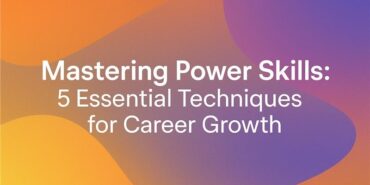Active listening: the underrated soft skill that drives leadership success

Many leaders believe they listen well. But there is a difference between hearing words and practising active listening. This capability, often dismissed as a “soft skill,” is a Power Skill that underpins effective leadership, stakeholder management, and conflict resolution.
In this article, we’ll examine what active listening really means, why it is critical for leadership success, and how Australian organisations can build it into leadership development pathways.
What active listening means
Active listening goes beyond silence while someone else speaks. It involves:
- Giving undivided attention and eliminating distractions.
- Demonstrating engagement through body language.
- Reflecting back and paraphrasing to confirm understanding.
- Asking open-ended questions that deepen dialogue.
- Responding with empathy, not just logic.
For example, in a stakeholder meeting about a new IT rollout, a project manager who simply “hears” objections may push ahead with their plan. A leader who actively listens surfaces deeper concerns — such as training gaps or workload fears — and addresses them before they derail adoption.
Why active listening is a Power Skill for leaders
- Trust and engagement: Employees who feel heard are more likely to remain engaged. A 2023 AHRI survey showed that “being listened to” ranks among the top three drivers of job satisfaction in Australia.
- Better decision-making: Leaders who listen gain access to perspectives they wouldn’t have considered.
- Conflict resolution: Many conflicts escalate because parties feel ignored. Active listening reduces defensiveness and opens dialogue.
- Stakeholder influence: Executives, clients, and partners are more likely to align with leaders who make them feel understood.
Techniques to develop active listening
Improving active listening takes structured effort.
- Removing distractions: Close laptops and silence phones during conversations. This signals genuine respect.
- Paraphrasing and reflecting: Simple phrases like “So what you’re saying is…” ensure alignment.
- Open-ended questioning: “What would success look like for you?” drives richer responses.
- Reading non-verbal cues: A pause or hesitation may reveal unspoken concerns.
- Pausing before responding: Allowing silence invites deeper thought.
These techniques are simple in theory, but challenging in practice — particularly under pressure. This is why courses like Communicating with impact and Optimising interactions with emotional intelligence dedicate training time to building active listening through role-play and feedback.
Real-world example
A senior consultant in Sydney improved stakeholder satisfaction scores after undertaking listening-focused training. By actively listening during meetings, he identified hidden resistance in a project and addressed it early, avoiding what could have been a costly derailment.
FAQs
Q: Is active listening the same as empathy?
Not exactly. Empathy is an attitude, while active listening is a set of techniques that demonstrate empathy.
Q: Can active listening be taught?
Yes. While some people have a natural tendency, structured training improves listening dramatically.
Conclusion
Active listening is not a passive act. It is a deliberate Power Skill that drives trust, leadership effectiveness, and organisational success. Leaders who practise it consistently become more influential and better equipped to navigate complex challenges.
👉 Learn how our leadership courses embed active listening as a critical Power Skill.



